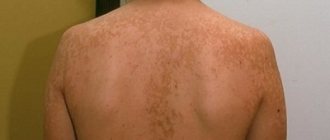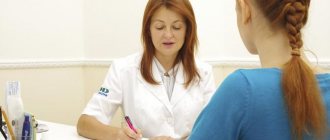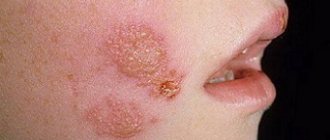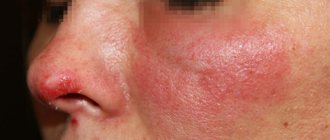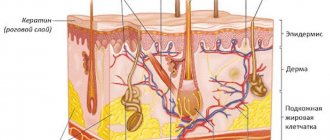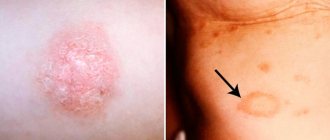- Initial appointment with a dermatologist
1200 ₽ - Calling a dermatologist to your home
4000 ₽
The disease occurs as a result of weak immunity. After recovery in patients, the body is able to produce antibodies to the pathology. Pityriasis rosea is an infectious disease. Rashes form on the skin, they are curable if therapy is prescribed in a timely manner.
Women are susceptible to deprivation much more often than men; it occurs in children aged 10 years. Pregnant women are susceptible to pathology as a result of hormonal changes. The peak of the disease occurs in the off-season, with weakened immunity.
Clinic specialists treat the disease. They will identify the causes, conduct research and prescribe therapy.
Varieties of pityriasis rosea
- Typical form. It is formed from the mother's plaque.
- Antitypical shape. There is no redness, but vesicles and blisters appear on the body. Itching appears and spreads to the face; this is not typical for a typical pathology. A rash is observed, small bubbles form, which merge into one whole, the size is 10 cm.
The flaky atypical form has several stages:
- itching on the skin, small rashes;
- the formation of papules that have a rough, fine-grained surface;
- Whole lesions are observed, they are noticeable among uninfected areas of the skin.
Symptoms of pityriasis rosea
The patient has a large pink spot. Its diameter is 20 mm or more. After a few days, the plaque becomes pale and yellow in color. The skin begins to peel off in the infected area. After the formation of spots, 3-5 days later they are observed on the body, arms, their diameter is 1 cm. The spots are pink, round or cylindrical in shape. The rashes begin to dry out and scales appear in the form of folds.
The patient's health worsens. Weakness, fever, headache, drowsiness, myalgia, redness of the throat, and poor appetite are observed. Based on the symptoms, pityriasis can be mistaken for an allergy. In this case, self-medication will lead to a deterioration in the patient’s health. The symptoms of the pathology are similar to other dermatological diseases.
The spots cover the back, thighs, arms and cause itching. They form within 3 weeks, then slowly disappear. The total duration of the pathology is up to 2 months. Dermatologists at the medical clinic treat patients with severe and initial forms of the disease.
Types of rashes
Spots are areas of a different shade from the surrounding skin. To the touch they can be smooth, protruding, or rough. Such manifestations on the surface of the skin are divided into 3 groups, which depend on the provoking factors and description.
- Vascular. Pinkish markings, available in red and purple.
Vascular spot - Pigment. The rash is white and brown in color. Appears against a background of deficiency or excess of melanin.
Pigment spots on the back - Artificial . Appear after the introduction of coloring substances under the skin - tattoo, permanent makeup.
In addition to this classification, there are separate types of marks related to certain pathologies. For example, ringworm. With it, papules disperse throughout the body. Depending on the type, they may also be on the head.
Vascular spots
| Name | Description |
| Hyperemic (blood) | Inflammatory and non-inflammatory. The first option arises against the background of current processes in the body. The size of the spots ranges from 2 cm (roseola) to 3-4 cm and above (erythema). The second option involves a rash that occurs as a result of an emotional outburst. Observed in the chest, neck, face |
| Hemorrhagic | Appear after a bruise or rough impact on the skin. They disappear on their own after 7-14 days. If bruises appear spontaneously and do not disappear for a long time, there is a risk of developing a disease that begins to affect blood vessels |
| Telangiectatic | These are spider veins that arise against the background of short-term dilation of blood vessels. Their occurrence is either congenital or acquired. There are many reasons for this - diet, bad habits, climate, temperature changes |
Dark spots
Markings of light and dark shades are observed on the skin if the amount of melanin has changed. The spots are:
- Hyper. The reason is increased pigmentation in a certain area. Congenital and acquired. The first includes birthmarks, the second - freckles.
- Hypo. The reason is a decrease in the amount of melanin. They also arise from birth and are acquired throughout life. The latter occur with psoriasis, lichen, and vitiligo.
Spots on the back with vitiligo
Age spots may appear if you often go to the solarium. Also, the cause is prolonged lack of treatment in the presence of inflammation on the skin. For example, acne often leaves behind marks. This also includes burns, cauterization of pimples, and rough squeezing.
Pregnancy and hormone intake are common causes for the formation of spots. If a person is prone to freckles, age spots will not bypass him. Old age is also included in this list.
Before you start fighting pigmentation, you need to know what caused it. This is due to the fact that some stains go away on their own, without wasting money and time.
Video - Why do brown spots appear on the skin of the chest and back?
Diagnosis of pityriasis rosea
The doctor will perform a diagnosis. At the first examination, he identifies the presence of a maternal plaque and determines the extent of the spread of rashes on the surface of the skin. Rarely, the pathology is similar to measles, eczema, rubella. The rash is similar to syphilis and is one of the signs of the disease.
Research is needed to confirm the disease. A urine and blood test will be required. If syphilis is suspected, a Wasserman test is performed. Also, a scraping is taken from the infected dermis and an examination is performed under a Wood's lamp. Diagnosing the disease in its early stages is difficult because maternal plaque is similar to other diseases. Doctors have extensive experience in treating pityriasis and will quickly identify it.
Diagnosis is prescribed by a dermatologist. Research is required to detect antibodies to the virus in a patient.
What you need to know about diagnosis and treatment
Diagnosis of pityriasis rosea is based on taking the patient's medical history. To confirm or refute and analyze complex cases, a number of laboratory tests are prescribed. They include clinical examination of blood and urine. It is necessary to exclude syphilis and mycosis, therefore serological and microscopic studies are additionally carried out. If these methods do not provide enough information to verify the diagnosis, the patient is referred for a biopsy (biopsy histology).
Treatment for pityriasis rosea is not always required. The disease is prone to voluntary self-healing within 5 weeks. However, dermatosis should not be considered harmless. First of all, antipruritic therapy is required. For this purpose, topical glucocorticosteroid drugs and antihistamines are used externally. Ointments, gels, pastes cannot be used without a dermatologist's prescription. Otherwise, the rash may increase the extent of skin damage, covering new areas. Antibiotics and antiviral drugs may be prescribed depending on the indications. Ultraviolet therapy has a good effect.
Differential diagnosis of pityriasis rosea with other diseases
The disease is differentiated from psoriasis, parapsoriasis, seborrheic eczema, syphilis, trichophytosis. The pathology differs from seborrheic eczema by the maternal plaque, the location of rashes that are not characteristic of eczema. Among other things, with seborrheic eczema the scales are often greasy.
Unlike psoriasis, lichen is spotty; it does not appear on the feet, hair, or hands. Difficult diagnosis is observed in the first stage of the disease.
There is a similarity between the disease and parapsoriasis; the spots may be similar. However, peeling and identical spots are not characteristic of lichen.
Lichen differs from syphilitic roseola in its brightness and the presence of peeling, since this is rarely found with syphilis.
Treatment of pityriasis rosea
To eliminate the disease, the dermatologist prescribes ointments, creams and tablets. These include:
- Acyclovir. It is used to inhibit pathogens. Experts advise applying cream or ointment every 4 hours. You can take the medicine in tablets.
- Flucinar. Reduces the formation of allergies, used for external use.
- Sinaflan. The medicine is an antihistamine, it is prescribed when lichen appears in children from 3 years of age and in adults. It is not recommended to use it for more than 7 days.
- Lokoid. Helps with allergies for women and when breastfeeding.
- Lorinden. Restores immunity, renews sleep, speeds up the healing process.
- Salicylic and zinc ointments. They have an antiseptic effect, prevent new skin rashes, and the spots dry out very quickly.
Dermatologists prescribe antiviral and antihistamine medications for therapy. If the pathology appears as a result of infection, antibacterial drugs are prescribed. Hormonal medications are prescribed in severe cases, if the disease is complicated by other chronic diseases.
For prolonged lichen, patients are prescribed antiviral drugs, it is recommended to treat stains with salicylic alcohol, as well as the use of ointments.
For symptoms of intoxication, the doctor prescribes activated charcoal as an auxiliary medicine.
The doctor prescribes antihistamines during therapy. These include Claritin, Tavegil, Loratadine, Suprastin. Taking medications is possible only on the recommendation of a doctor.
Why should you contact our clinic?
Dermatologists of the highest category
Experienced dermatologists in Moscow. Experience of specialists from 15 years.
Modern equipment
Modern equipment from the world's best manufacturers.
Expert class equipment
Ultrasound is performed using expert-class equipment manufactured by General Electric, SONY, Mindray.
Tests and ultrasound on the day of treatment
Tests, x-rays, ultrasound with interpretation, dressings on the day of treatment in Moscow.
Consultations for adults and children
A network of dermatological clinics in Moscow. Clinics near the metro.
Experienced doctors
Our experienced doctors with over 15 years of experience. Candidates of Medical Sciences.
Methods of infection
To date, there is no consensus on the methods of infection.
There is an assumption that the source of the disease is the herpes virus and that people with low immunity, those who have recently suffered viral infections, colds, and who are often hypothermic are primarily at risk of contracting Zhiber's disease. Women and children have a significantly higher risk of infection than men. Observations show that people over 40 years of age and infants practically do not become infected with this infection. Is this disease contagious? There is no clear answer to this question. There is an opinion that it can be transmitted through tactile contact or airborne droplets. A prerequisite for a person to become infected is the presence of a provoking factor. In practice, it has been noted that transmission of this virus from one person to another occurs infrequently.
Prevention of pityriasis rosea
- regular walks;
- reduce consumption of fatty foods and foods containing dyes;
- include multivitamins in your diet only on the recommendation of a dermatologist;
- change bed linen and clothes regularly;
- Perform water procedures regularly;
- undergo preventive examinations;
- avoid stress;
- Do not use hard washcloths that irritate the skin.
The diet should be balanced; our doctors will recommend that the patient monitor the amount of carbohydrates and proteins. It is better to include fermented milk products, cereals, bread, and lean beef in the menu. Vegetables and berries are useful for treating the disease.
How to avoid infection
Due to the fact that the nature of the occurrence of Gibert's disease has not been thoroughly studied, there are no methods to prevent this disease. The main recommendation is to monitor the state of the immune system, as it will help avoid infection.
Complications
The disease itself in most cases goes away without leaving a trace. However, sometimes complications arise in the form of eczema, staphylococcus or streptococcus; ring-shaped lichen can develop, which quite often becomes chronic and even after a few years a relapse can occur. Then treatment is done with antibiotics. To prevent such problems, we strongly recommend that you undergo comprehensive treatment in our clinic. Don't forget about your health and the health of your family!
Complication of pityriasis rosea
Relapses do not occur very often, but in some cases there are complications. These include folliculitis, eczema, osteofolliculitis and others. Re-infection can occur as a result of wearing uncomfortable clothes, not following therapy, or in people who suffer from allergies.
Secondary disease is typical on skin that is subject to stretching: thighs, groin, forearms. Infection appears in the sweat glands or on the skin of the face. If you notice the appearance of lichen, immediately contact a specialist. Timely treatment will avoid negative consequences.
Pityriasis rosea in children
Pityriasis is diagnosed in children over 5 years of age. The dermatologist prescribes antihistamines and multivitamins to patients, which restore the immune system. For children under 2 years of age, the doctor prescribes antiseptics and zinc ointment.
Children with weak immunity are susceptible to pathology in the fall and spring. The disease is diagnosed more often in girls, less often in boys. Rashes are rare in infants. The reason is overheating or hypothermia of the baby.
Causes of skin disease:
- allergic reactions to foods or fabrics;
- intestinal disorder;
- depression, emotional turmoil;
- insect bites.
The specialist will recommend medications to speed up recovery. The disease period is up to 2 months. To destroy microorganisms, it is necessary to take antibiotics, and for allergies - antihistamines. At high temperatures, the doctor prescribes antipyretic tablets.
Pityriasis rosea during pregnancy
The appearance of pityriasis is frequent with hormonal changes in the patient’s body or with a reaction to any foods. The pathology can be dangerous for the health of mother and baby, but it causes discomfort, itching and spots appear. The cause of the disease is weak immunity.
During lactation, women are not prescribed hormonal or antiviral drugs. When itching occurs, the dermatologist prescribes antihistamines, taking into account the woman’s condition. Ointments containing zinc are prescribed as external agents.
In pregnant women in the early stages, lichen has a negative effect on the fetus, since the disease is infectious. The child will not be able to become infected, but there is a possibility of miscarriage or the birth may be premature. Patients who are up to 15 weeks pregnant are susceptible to infection.
If lichen appears, you should consult a doctor. He will prescribe antihistamines in case of swelling, antibiotics if the disease causes complications. He will also prescribe vitamins C, A, B. Sedatives will need to be taken if there is a risk to the fetus. Taking medications on your own is not recommended, as this may have a negative effect on the child.
What does the appearance of red moles on the body mean?
If red moles appear on the body, this may be a simple cosmetic defect, or it may indicate pathological processes occurring in the body. In some cases, the occurrence of angiomas indicates poor nutrition, prolonged exposure to the sun, and a sludge buildup in the body.
Red dots like moles may indicate increased estrogen levels in the body, liver dysfunction and increased insulin in the blood. In addition, in some cases, angiomas appear as a response of the body to a lack of iodine, magnesium, chromium, vitamins C and K.
